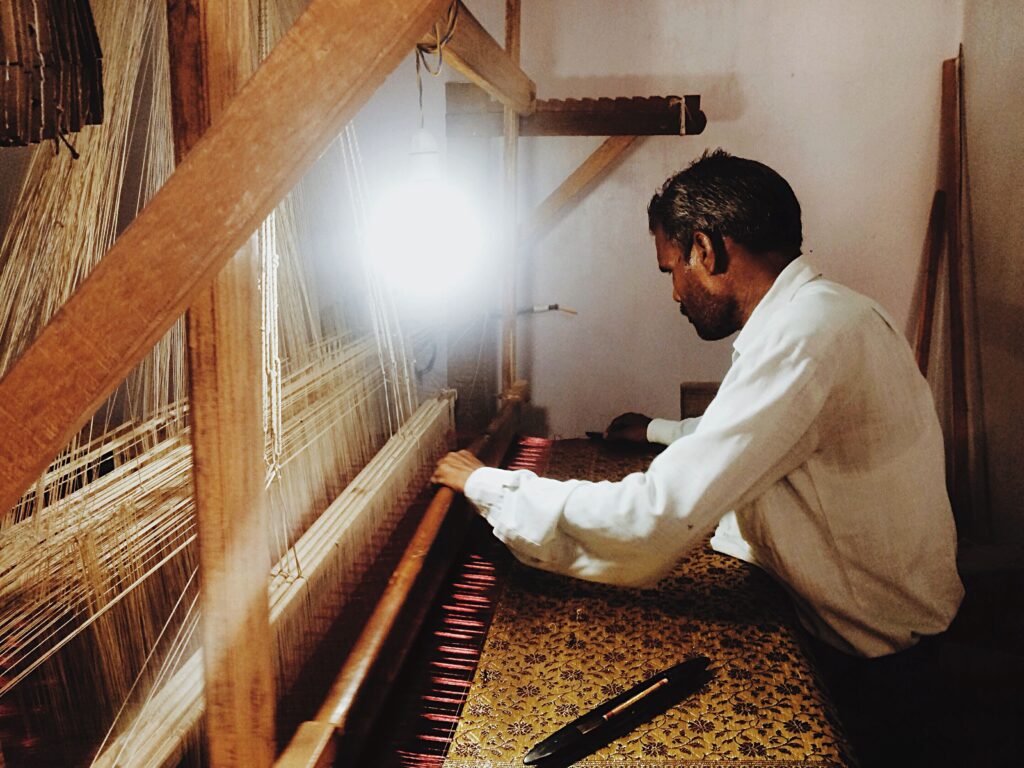Guide to Buying Benarasi Sarees for International Tourists
Benarasi sarees are a timeless symbol of Indian heritage, renowned for their exquisite craftsmanship, intricate designs, and rich cultural significance. Originating from the ancient city of Varanasi, these sarees have adorned women for centuries and remain a favorite among international tourists seeking a piece of Indian tradition. Their unique blend of elegance and sophistication makes them a must-have in every wardrobe.
Here are some fantastic places you can visit on your next immediate family tour from Kolkata.

The history of Benarasi sarees dates back to the Mughal era when artisans began weaving intricate patterns using silk and gold threads. The city of Varanasi became a hub for silk weaving, and the sarees produced here gained recognition for their luxurious quality and artistry. Today, Benarasi sarees are not just limited to Indian markets; they have found their way into international fashion, gracing runways and red carpets around the globe.
Types of Benarasi Sarees
The diversity in Benarasi sarees is remarkable, with each variant showcasing unique features.
Katan sarees are made from pure silk and are known for their smooth texture and rich colors. The weaving process involves twisting silk threads to create a durable fabric. These sarees often feature intricate patterns, making them a popular choice for weddings and formal occasions.
Shattir sarees are lightweight and trendy, crafted from a blend of silk and other materials. They are ideal for warmer climates and casual outings, offering both comfort and style. The elegant drape of Shattir sarees makes them suitable for various occasions.
Organza (Kora) sarees are characterized by their delicate and sheer fabric, adorned with intricate zari work. The sheer texture allows for creative styling, making these sarees perfect for festive events. The craftsmanship involved in creating Organza sarees highlights the artisanal skills passed down through generations.
Georgette sarees are lightweight and flowing, made from a blend of silk and synthetic fibers. They offer a modern twist to the traditional Benarasi saree, making them suitable for both casual and formal wear. The soft drape and vibrant colors make Georgette sarees a popular choice among younger generations.
Jangla sarees are known for their intricate floral motifs and heavy zari work, a feast for the eyes. The elaborate designs often feature peacock patterns, symbolizing beauty and grace. These sarees are ideal for weddings and special occasions, as they exude elegance and opulence.

Understanding Weaving Techniques
The craftsmanship behind Benarasi sarees is a labor of love, with weaving techniques that have been perfected over centuries.
Handwoven vs. Machine-made: Authentic Benarasi sarees are handwoven, often taking several days or weeks to complete. The intricate designs and patterns are woven into the fabric using traditional looms, ensuring each piece is unique. Machine-made versions, while more affordable, lack the intricate artistry and authenticity of handwoven sarees.
Zari Work refers to the gold or silver threads used to embellish sarees. The skillful incorporation of zari into the fabric creates stunning designs that shimmer and shine. Traditional artisans handcraft these designs, which often include intricate motifs and patterns. The quality of zari is a significant factor in determining the saree’s value, with pure gold and silver threads fetching higher prices.
The weaving techniques reflect the rich heritage of Varanasi, where artisans continue to practice their craft with pride. With the rise of international markets, the demand for authentic Benarasi sarees has increased, creating opportunities for artisans to showcase their skills to a global audience.

Where to Buy Benarasi Sarees
When searching for Benarasi sarees, Varanasi remains the top destination, but other cities also offer authentic options.
Varanasi is the heart of Benarasi sarees, and local markets like Thateri Bazaar are great places to explore. Artisans sell handwoven sarees directly, and interacting with them can provide insights into their craft and the stories behind each saree.
Kolkata is known for its rich textile heritage. Markets like Gariahat Market or New Market offer a wide variety of sarees, including both traditional and contemporary designs.
Delhi features bustling markets like Chandni Chowk, famous for textiles. You can find numerous shops specializing in Benarasi sarees, offering a range of styles and price points.
For those unable to visit India, numerous online platforms provide authentic Benarasi sarees, allowing international tourists to explore collections from the comfort of their homes.

Recognizing Authentic Benarasi Sarees
To ensure you are purchasing a genuine Benarasi saree, keep these tips in mind:
Check the Zari Work: Authentic sarees will feature intricate zari work, often shimmering with a golden hue. Ensure that the zari is woven into the fabric and not just printed on.
Inspect the Silk Quality: High-quality silk will feel smooth and luxurious to the touch. Run your fingers over the fabric to check for texture and weight.
Look for Handwoven Patterns: Each handwoven saree will have slight variations, making it unique. Machine-made sarees tend to have uniformity in design.

Price Range and Budget
The price of Benarasi sarees can vary significantly based on the type, material, and craftsmanship.
Katan sarees generally range from INR 5,000 to INR 30,000 or more, depending on the intricacy of the designs and the quality of silk used.
Shattir sarees are more budget-friendly, with prices typically between INR 2,000 and INR 10,000.
Organza sarees can be found for around INR 3,000 to INR 15,000, depending on the zari work.
Georgette sarees often range from INR 2,500 to INR 12,000.
Jangla sarees, due to their heavy embellishments, may cost between INR 10,000 and INR 50,000 or more.
Bargaining is common in Indian markets, so don’t hesitate to negotiate the price when shopping.
How to Style a Benarasi Saree
Styling a Benarasi saree can elevate your look for various occasions. Here are some tips:
Traditional Styling: Pair your saree with traditional jewelry like gold or silver bangles, jhumkas (earrings), and a statement necklace. A classic bun adorned with fresh flowers adds to the elegance.
Contemporary Styling: For a modern twist, wear your saree with a fitted blouse or crop top. Experiment with draping styles, such as the Bengali or Nivi drape, for a contemporary flair.
Accessorizing: Choose accessories that complement your saree’s color and design. A chic clutch or potli bag can enhance your overall look.
Care and Maintenance of Benarasi Sarees
To keep your Benarasi saree looking beautiful for years, follow these care tips:
Storage: Store your saree in a cotton or silk pouch, away from direct sunlight. Avoid using plastic bags, as they can trap moisture and lead to damage.
Washing: Hand wash your saree in cold water using mild detergent. Avoid wringing or twisting the fabric to prevent damage. For heavy zari work, it’s best to opt for dry cleaning.
Preservation: Keep your saree away from moths and insects. Using cedar balls or neem leaves in your storage can help protect the fabric.
Cultural Significance and Occasions
Benarasi sarees hold a special place in Indian culture, particularly during weddings and festivals. They are often gifted to brides as a symbol of love and prosperity. Wearing a Benarasi saree during auspicious occasions is considered a blessing and enhances the festive spirit.
When purchasing a Benarasi saree as a souvenir or gift, you are not just acquiring a piece of clothing but a piece of Indian culture and tradition that reflects the rich heritage of the country.
Souvenir Value
A Benarasi saree makes for a unique and valuable souvenir, representing the artistry of Indian textiles. It’s an excellent gift for friends and family, allowing them to experience a piece of India. When you bring back a Benarasi saree, you’re sharing not just a garment but a story of craftsmanship, tradition, and elegance.
Additional Tips for Tourists
When shopping for Benarasi sarees, keep in mind the following tips:
Market Etiquette: Engage with local sellers politely, and take your time to explore different shops. Ask questions about the sarees to learn more about their history and craftsmanship.
Language Barriers: While many shopkeepers understand English, learning a few basic Hindi phrases can enhance your shopping experience and help you connect with locals.
Tax and Customs Information: Check your home country’s customs regulations regarding textile imports to avoid surprises upon your return.
Exploring the world of Benarasi sarees is a delightful journey filled with culture, craftsmanship, and elegance. With their timeless appeal and rich heritage, these sarees are more than just clothing—they are a reflection of India’s artistic soul, making them a perfect addition to any wardrobe. Whether you’re attending a wedding, a festive occasion, or simply wish to embrace the beauty of Indian fashion, a Benarasi saree is an investment you won’t regret.

